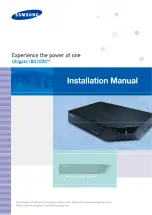
3
Dell Networking 207 Series Access Points
| Installation Guide
Access Point Pre-Installation Checklist
Before installing your 207 Series access points, ensure that
you have the following:
Cat5E or better UTP cable of required length
One of the following power sources:
IEEE 802.3af-compliant Power over Ethernet (PoE)
source.
Dell AP-AC-12V30B power adapter kit (sold
separately)
For W-AP207 only:
Dell Controller provisioned on the network:
Layer 2/3 network connectivity to your access point
One of the following network services:
Aruba Discovery Protocol (ADP)
DNS server with an “A” record
DHCP Server with vendor-specific options
Verifying Pre-Installation Connectivity
Before installing access points in a network environment,
make sure that they are able to locate and connect to the
controller after power on.
Specifically, you must verify the following conditions:
When connected to the network, each access point is
assigned a valid IP address
Access points are able to locate the controller
Refer to the AOS Quick Start Guide for instructions on
locating and connecting to the controller.
Pre-Installation Network Requirements
After WLAN planning is complete and the appropriate
products and their placement have been determined, the Dell
controller(s) must be installed and initial setup performed
before the Dell access points are deployed.
For initial setup of the controller, refer to the AOS Quick
Start Guide for the software version installed on your
controller.
Identifying Specific Installation
Locations
You can mount the 207 Series access point on the ceiling or a
wall. Use the access point placement map generated by Dell
VisualRF Plan software application to determine the proper
installation location(s). Each location should be as close as
possible to the center of the intended coverage area and
should be free from obstructions or obvious sources of
interference. These RF absorbers/reflectors/interference
sources will impact RF propagation and should have been
accounted for during the planning phase and adjusted for in
RF plan.
Identifying Known RF Absorbers, Reflectors and
Interference Sources
Identifying known RF absorbers, reflectors, and interference
sources while in the field during the installation phase is
critical. Make sure that these sources are taken into
consideration when you attach an access point to its fixed
location. Examples of sources that degrade RF performance
include:
CAUTION: EU Statement:
Lower power radio LAN product operating in 2.4 GHz
and 5 GHz bands. Please refer to the
User Guide
for
details on restrictions.
Produit réseau local radio basse puissance operant
dans la bande fréquence 2.4 GHz et 5 GHz. Merci de
vous referrer au manuel utilisateur pour les details
des restrictions.
Low Power FunkLAN Produkt, das im 2.4 GHz und im
5 GHz Band arbeitet. Weitere Informationen
bezlüglich Einschränkungen finden Sie im
benutzerhandbuch..
Apparati Radio LAN a bassa Potenza, operanti a
2.4 GHz e 5 GHz. Fare riferimento alla manuale utente
per avere informazioni detagliate sulle restrizioni.
Note: Dell access points are designed in compliance with
governmental requirements, so that only authorized network
administrators are permitted to change the settings for this
device. For more information about access point
configuration, refer to the Quick Start Guide and User Guide
for your device.
Note: The instructions for this section are applicable to the
W-AP207 only.
Note: The instructions for this section are applicable to the
W-AP207 only.























